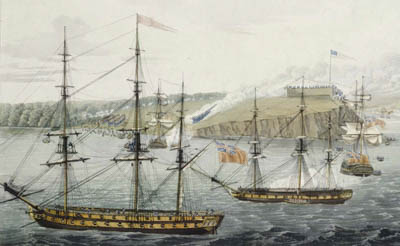Address: 9 Morton St, Prince Regent and Princess Charlotte are underwater in Deadman Bay and St. Lawrence is in a bay near 9 Morton St., Kingston, Ontario
Recognition Statute: Historic Sites and Monuments Act (R.S.C., 1985, c. H-4)
Designation Date: 2014-07-07
Dates:
- 1814 to 1814 (Construction)
Other Name(s):
- War of 1812 Shipwrecks (Designation Name)
- HMS St. Lawrence (Historic Name)
- HMS Princess Charlotte (Other Name)
- HMS Prince Regent (Name of contributing resources)
Research Report Number: 2012-21, 2011-72
Plaque(s):
Near here, in Kingston Harbour, lie the wrecks of HMS Prince Regent, HMS Princess Charlotte, and HMS St. Lawrence, the most powerful British warships built in Canada during the War of 1812. St. Lawrence was the largest and most heavily armed warship of its time on fresh water, gaining ascendancy on Lake Ontario without having to fire a shot in anger. These vessels speak to the rapid mobilization of supplies, skills, and labour under the Royal Navy’s substantial shipbuilding program. The wrecks are a tangible reminder of the magnitude of the arms race for control of the lake during the War of 1812.
Commemorative Intent:
HMS St. Lawrence was the largest and most heavily-armed warship of its time serving on fresh water (comparable in size and fire power to Nelson’s Victory) achieving British ascendancy on Lake Ontario without having to fire a shot in anger. Together, the HMS Prince Regent, Princess Charlotte and St. Lawrence were the most powerful British warships built in Canada during the War of 1812;
Built in the dockyards at Kingston, they are a tangible reminder of the Royal Navy’s substantial shipbuilding program during the war, and the rapid mobilization of supplies, skills and labour from both British North America and Britain to build ships adapted to the conditions of the lake;
No longer needed following the terms of disarmament in the Rush-Bagot Agreement (1817), the three ships became shipwrecks. They continue to attest to the magnitude of the arms race between the Americans and the British and its role in determining the outcome of the war and the succeeding peace.
Learn more at: Parks Canada Directory of Federal Heritage Designations





